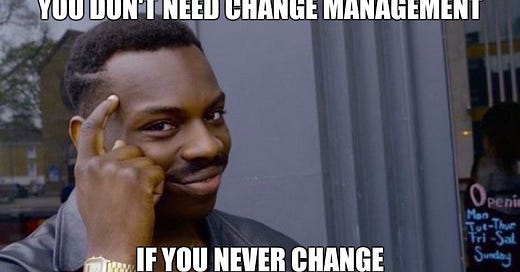Cannabis Winners Will Be Change Mavens
To say that the cannabis industry is dynamic would not be an understatement. A firm’s ability to scale up or down to meet demand, launch new initiatives & markets or respond to a crisis can be the difference between winning and losing in this hyper competitive market.
Yet research says as much as 70% of change management initiatives fail. We’ve all seen new strategies and initiatives die on the vine. Yet, failure need not be a forgone conclusion.
I’ve worked with cannabis firms that mastered the art of change management. They followed these 6 best practices, which include a dollop of behavioral psychology:
1) Tell a compelling story, repeatedly
Regularly communicate a single, inspiring story across the organization. This “narrative” should resonate with a person’s brain (i.e. what’s good for them & the company) and their heart (i.e. how it links to their purpose).
2) Be practical
According to Diffusion theory, embracing a new behavior typically follows a diffusion curve - early adopters, safe followers, latecomers and malcontents. Managers need not try to change everyone all at once but instead focus on small groups and early wins. They should enlist a few early adopters to embrace the change. These adopters along with management would find and convince the influencers, who then perform their persuasion magic within their organizational networks.
3) Activate coworkers
According to Social Comparison theory, people look to those in their immediate circle for guidance for what are acceptable behaviors. Peers can set expectations, shame us or act as positive role models. Companies should establish change agents across the firm and encourage them to set expectations and respectfully nudge their co-workers towards compliance.
4) Leverage leadership
Change initiatives often come up short when employees disengage after not seeing their managers “walk the walk.” Leaders should consistently be engaged in the transformation through implementing change initiatives as well as modelling good behaviors. Management must also proactively support the effort by rewarding good actions, providing coaching and censuring non-compliance.
5) Tweak the management system
In many cases, organizational policies (e.g., performance metrics, budgeting, etc.) are barriers to change. Managers should identify and remove these potential roadblocks in advance of launching any change initiatives.
6) Change the environment
Behavioral Decision theory says that adjusting the situation around a person can trigger change. As an example, Google wanted to promote healthier eating among their employees. Using the cue that people tend to grab what they see first, the company stationed the salad bar in front of the room.
#changemanagement #transformation #leadership #behavioralpsychology


